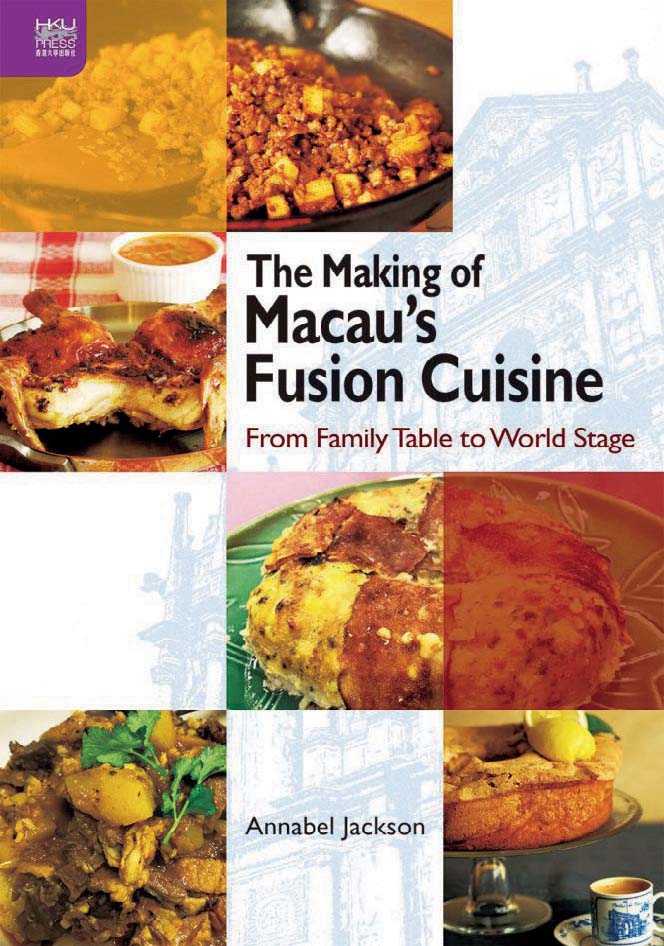Foodways of Macao
Annabel Jackson. 2020.
The Making of Macau’s Cuisine: From Family Table to World Stage
Hong Kong: Hong Kong University Press
ISBN 9789888528349
Having lived in Macao for over 15 years, I thought I knew quite well what Macanese food was all about. That is, until I read Annabel Jackson’s new book, The Making of Macau’s Cuisine. Trained in anthropology and a recognized food critic, the author carefully examines the history, nature, and roles that food has played in Macao and in other Portuguese settlements in Asia. The inclusion of the other Portuguese creolized foodways of Goa and Malacca provides not only useful comparisons but are also important for understanding the close interconnections and similarities between these cuisines.
Although not well known outside eastern Asia and often misconstrued, Macanese food is one of the world’s earliest fusion cuisines. When the Portuguese founded Macao nearly 500 years ago, it was a relatively barren stretch of sand dunes and low hills, with only one or two fishing villages and an A-Ma Temple. In building the city the early settlers, who were all males, needed to import nearly everything from outside, including food and women from other Portuguese colonies in Africa and Asia. So right from the start, Macao’s foodways borrowed from and adapted to the foods, spices, and cooking styles of a large variety of peoples. In recognition of its unique cuisine in 2017 Macao became a UNESCO Creative City of Gastronomy and its cuisine has since entered the world stage.
Fusion cuisine
As Jackson explains, because Macanese food had its origins in the fusion of many diverse cuisines and has continued to evolve over the centuries, it is impossible to pinpoint what exactly constitutes Macanese food. Even within the Macanese community at large, there is little consensus as to what comprises Macanese cuisine. For purists, in fact, it has become a lost art, yet for most ordinary tourists, who want to enjoy a different cuisine, it is simply the food prepared in restaurants in Macao. Indeed, today in most restaurants in Macao, whether categorized as Portuguese or Cantonese, they all include dishes on their menus purporting to be Macanese. This raises the question of authenticity. What is Macanese cuisine? What locals and tourists nowadays eat at home and in restaurants is a far cry from what the people living in Macao ate several centuries ago. People and their tastes have continually changed over the centuries and so have ingredients, flavors, and cooking styles. As the author rightly explains, the nature of Macanese food is adaptation.
Cuisines are always evolving. From its origins in the Portuguese colonies, Macao’s early foodways followed the spice trade from Africa to India to Southeast Asia to Macao and Japan. Take the iconic Macanese dish, African Chicken, which likely was invented only in the 1940s, believed to have been created by chef America Angelo at the former Pousada de Macao. In its earliest forms, it was blackened and spicy with a marinade of butter, garlic, and chilies, but today in most versions it is baked in a tomato and peppery peanut sauce. It is a typical creolized dish that combines flavors from Mozambique, Goa, and Malacca, and each of these places also have their own versions of the same dish with different names. Today Macanese cuisine has progressed from its traditional Portuguese foundations to a creolized mixture of Portuguese and Asian cooking, to what is more recently heavily influenced by Chinese cuisines. For Macao fusion food represents something new and distinct.
Macanese food and identity
Another topic discussed throughout the book concerns questions of identity. Who are the Macanese and what role does food play in their identity? Food is an important cultural marker for most groups of people. To be considered a true Macanese, as the author points out, one must have some Portuguese ancestry. Like their cuisine, the Macanese people are an eclectic mixture of different and evolving ethnic groups. At first the Macanese were the offspring of the original male Portuguese settlers and females from their colonies in Mozambique, Goa, and Southeast Asia. Later, in the 20th century, the so-called Neo-Macanese are the progeny of Portuguese or Macanese fathers and Chinese mothers. Thus, in terms of foodways, family recipes included a large mixture of different culinary tastes and techniques yet were nonetheless considered Macanese. As food styles changed over time so too did perceptions of one’s identity.

Interestingly, today there are more people who identify themselves as Macanese who live outside Macao than inside the city itself. There is a large Macanese diaspora spread across the globe. As a critical part of her research, Jackson conducted a large number of interviews and surveys of Macanese living in Hong Kong, Europe, North America, and Australia. Because many diasporic Macanese people have a sense of rootlessness, memories of home foods and recipes have become important identifiers of their common culture and values. In creating an identity, in fact, the sharing of recipes and the production of cookbooks have become crucial. As the author explains, today Macanese food has moved away from being everyday food to something more symbolic and ceremonial. How one remembers the aromas and tastes of certain foods is as important as the actual foods themselves. At the same time, with the diaspora Macanese cuisine has diffused around the world in trendy ethnic restaurants. For most Macanese both at home and abroad, food is decisively embedded in their notions of identity.
In conclusion, this is a concise and fascinating book on a little-known and often misunderstood fusion cuisine that should be of interest to anyone wanting to learn about Macao and the dissemination of food culture in general. There is indeed more to Macao than merely casinos and gambling.
Robert Antony, Shandong University, China
